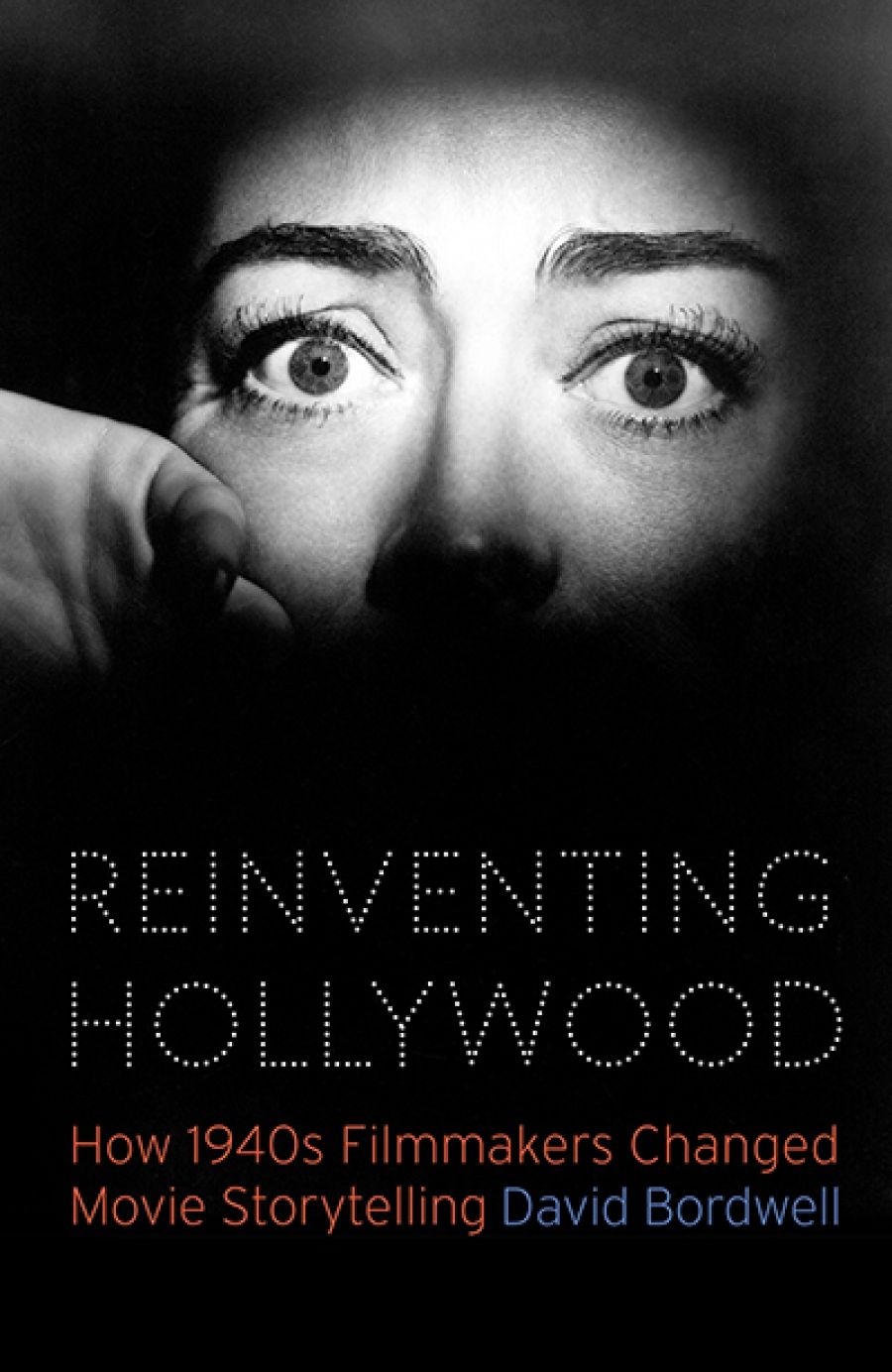
- Free Article: No
- Contents Category: Film
- Custom Article Title: Desley Deacon reviews 'Reinventing Hollywood: How 1940s filmmakers changed movie storytelling' by David Bordwell
- Custom Highlight Text:
With the Harvey Weinstein scandal and the #MeToo movement reminding us all too vividly of flesh and blood Hollywood, David Bordwell’s cerebral Reinventing Hollywood: How 1940s filmmakers changed movie storytelling seems to come from another planet. But Bordwell, who is the Jacques Ledoux Professor of ...
- Book 1 Title: Reinventing Hollywood
- Book 1 Subtitle: How 1940s filmmakers changed movie storytelling
- Book 1 Biblio: University of Chicago Press (Footprint), $84.99 hb, 572 pp, 9780226487755
Bordwell is unabashedly a fan of Hollywood in the 1940s, when it became, especially in the ‘Five Fat Years’ between 1942 and 1946, ‘a machine for producing pleasure on a scale the world had never seen before’. He recalls in his preface how he grew up watching the classics of his parents’ generation on television – The Magnificent Ambersons, His Girl Friday, The Best Years of Our Lives, Notorious, How Green Was My Valley, Meet Me in St Louis – giving him ‘goosebumps of delight’.
This fandom sits awkwardly with his academic scrupulousness. In Reinventing Hollywood, he focuses at great length on the ways in which 1940s Hollywood played brilliantly with standard narrative devices and invented new ones. In multi-chapter sections on chronology, the patterned flow of narration, and new forms of storytelling, he discusses flashbacks, the voiceover (‘Last night I dreamt I went to Manderley again’), dream sequences, the quasi-documentary, and much more. Here he is concerned to sample Hollywood films in an un-biased way. ‘Quality,’ he asserts, ‘isn’t my sole concern.’ The result is a bewildering – if scientifically justified – torrent of references to, and analysis of, movies most people have never seen, or are likely to see. But Bordwell, like the rest of us, has his favourites, and he indulges his enthusiasms in ‘depth soundings’ in ‘Interludes’ that allow him to analyse ‘the Masters’, Alfred Hitchcock and Orson Welles, major innovators such as Joseph L. Mankiewicz and John Sturges, and the emblematic 1940 Academy Award winner, Our Town.
Despite its length and its mind-numbing references to almost every movie made in the period, Reinventing Hollywood convinces us that the 1940s was indeed a glorious time for film. Audiences had money to spend; fan magazines proliferated; studios brought out more ‘A’ pictures; radio, novels, plays, and magazines borrowed from each other, developing what he calls a ‘user-friendly modernism’ that reworked the way stories were told. Bordwell is especially interesting in his discussion of the mystery, which became, in his words, a ‘mega-genre’ in the forties. As he puts it, the mechanics of suspense were lifted to a new respectability in such films as Rebecca (1940). An element of mystery was added to comedies, westerns, family dramas, war stories, romances, and exposes; and it encouraged the use of such devices as flashbacks, replays, voiceovers, restricted viewpoint, and suppressive narration; the story could be told from the viewpoint of the victim, as in Rebecca, or of the bystander, a 1940s technique that reached its apogee in Rear Window (1954). These mysteries, which were increasingly ‘A’ releases, were often psychological, with films such as Laura and Gaslight (both 1944) women-centred thrillers with killers who were no longer criminals on mean streets but urbane charmers operating at cocktail parties and in classy restaurants.
 Laurence Olivier and Joan Fontaine in Rebecca, 1940 (Twentieth Century Fox)
Laurence Olivier and Joan Fontaine in Rebecca, 1940 (Twentieth Century Fox)
The general reader turns with relief to Bordwell’s ‘Interludes’ and the familiarity of his heroes, Welles and Hitchcock. Rebecca of course won the Academy Awards Best Picture in 1941 and made Australian-born Judith Anderson an enduring icon of movie menace. Bordwell demonstrates how it introduced or built upon a variety of narrative devices that became standard over the next decade: the enigmatic husband – is he or is he not a murderer? extreme restriction of viewpoint – what does Mrs Danvers know that the wife does not? subjective sound and camerawork – the sound of the sea and the effect of shadows in conveying the wife’s mental state. Hitchcock’s innovations were quickly copied, and directors such as Billy Wilder were out to ‘Out-Hitch Hitch’ in such films as Double Indemnity (1944).
In an interesting concluding chapter, Bordwell discusses the influence of Hollywood on postwar Europe, where the ‘Young Turks’ of Cahiers du Cinéma saw Hollywood as a ‘chosen land, that haven which Florence was for painters of the Quattrocento or Vienna for musicians in the nineteenth century’; and he argues that ‘the syntax of 1940s Hollywood remains basic to modern moviemaking’. Bordwell does convince us that how the story is told is at least as intriguing and exhilarating as the movie story itself. So dip into this book judiciously if you want to capture that exhilaration, or you will be drowned in the detail, and enjoy the many fascinating images from more movies than you are ever going to see.


Comments powered by CComment